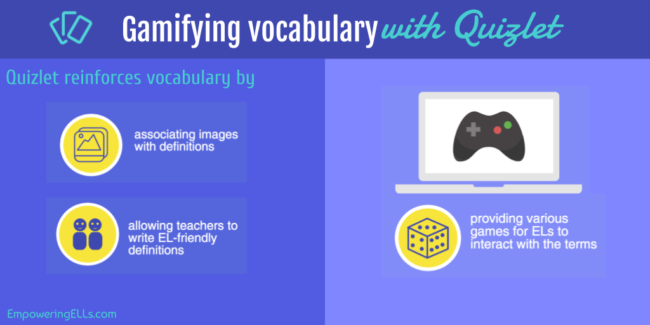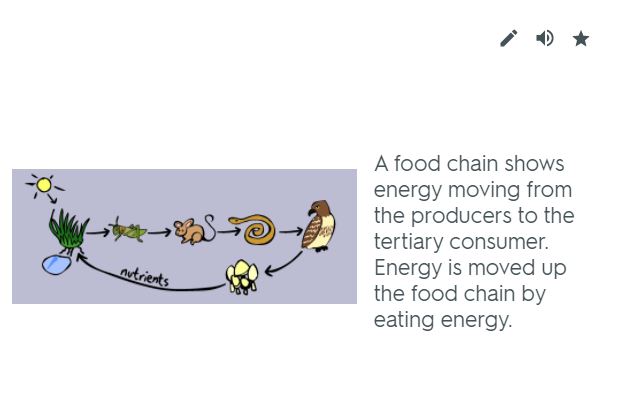This is Part 10 of Transforming Instruction Through Technology series. This article about using Quizlet focuses on using technology to teach vocabulary.
Vocabulary is the gatekeeper to the land of high academic achievement. ELs have to draw from their bank of words for admittance. And only those with the most accurate use of vocabulary are allowed entrance.
Research indicates that the development of vocabulary plays the most critical role in ELs’ language acquisition and academic achievement (August, Carlo, Dressler, & Snow, 2005; Chung, 2012). Because vocabulary impacts students’ general comprehension, research suggests that explicit vocabulary instruction enhances reading comprehension as well (McKeown, Beck, Omanson, & Perfetti, 1983).
Beck, McKeown, and Kucan state that, “The major purpose of having a large vocabulary is to use it in the service of reading comprehension and writing” (2008, p. 183). Technology can help ELs acquire vocabulary, specifically content-specific words, so that they can engage and create with content knowledge.
Interacting with Vocabulary Words
There are three ways that technology can facilitate vocabulary acquisition:
- pictures,
- EL-friendly definitions, and
- interactive practice.
1) Associating Pictures with Definitions
When teaching content vocabulary, start with using pictures. Content vocabulary can be represented with images. For example, the word “ecosystem” consists of the environment and organisms interacting with each other. An image of an ecosystem can house all of these elements. The images effortlessly facilitate comprehension of a word when the definition is too abstract or complex.

2) Writing ML-Friendly Definitions
Definitions are at the center of understanding a vocabulary word. However, they’re often quite abstract, using unknown vocabulary words written in complex phrases. For example, the Google defines “require” in the abstractions below:
Google’s definition of “require” is “need for a particular purpose”. Most ELs would find that difficult to understand because it’s just too abstract.
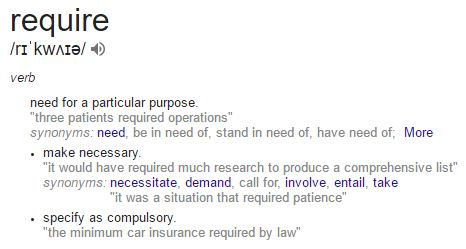
It’s more effective to define a word using a full sentence to provide context. We can also use words that are familiar to ELs to facilitate comprehension.
Instead, my ML-friendly definition for “require” would be:
When someone requires something, they need that thing. Because my mom requires that I wear a helmet when riding my bike, I had to wear the helmet before I left.
Notice that this definition was EL-friendly because:
- The definition was written in a full sentence
- Context was added to help comprehend the vocabulary word, and
- The vocabulary word was used in a complete sentence.
Traditional dictionary-based definitions sacrifice context for brevity and word economy. However, for ELs, context can’t ever be spared.
3) Providing Interactive Practice
Practice needs to go beyond memorizing the definition to interacting with the words. Software programs provide various ways to play with content words, such as:
- matching pictures to their definition,
- playing racing to match answers,
- and typing definitions.
The interactive capabilities push beyond the traditional flashcard method to providing more ways to interact with the vocabulary words. These programs can even group words for students – offering differentiation. When student play games, teachers can get data to inform their instruction.
Even though these interactions are not as effective as providing a context for the vocabulary words, the interactive functions still increase engagement with the words in focus.
Recommended Programs
Two programs that include these three elements are Speak Agent and Quizlet. Speak Agent is fantastic for primary school students and is designed for these young learners in mind. It gamifies learning academic vocabulary for K-4th graders. Because I work in a secondary school, I exclusively use Quizlet in content classes.
If you’re interesting enhancing learning for ELs by integrating technology, please consider reading ELL Frontiers: Using Technology to Enhance Instruction for English Learners by Heather Parris, Lisa M. Estrada, and Andrea Honigsfeld. By purchasing the book, you also support this blog.
The Power of Quizlet
Embedding Images
Quizlet allows teachers to assign an image with a term. Mr. Arno had specific words he wanted students to learn during the 7th grade ecosystem unit. We wrote EL-friendly definitions, and then we used the image search function already embedded in Quizlet to connect the words to images. This is our actual Quizlet still in use today.
When I typed in “food chain” in Quizlet, three pictures came up, and I chose this one.
Changing Languages
Quizlet has a magical function that turns our English definitions into 18 languages. However, because Zheng Hong is learning the science content through English and his science teacher doesn’t speak Chinese, I still recommend that Zheng Hong learn the vocabulary words in English. He can refer back to Chinese, but he needs to hear it in English and be able to use the English version of the vocabulary words to communicate his understanding of ecosystems.
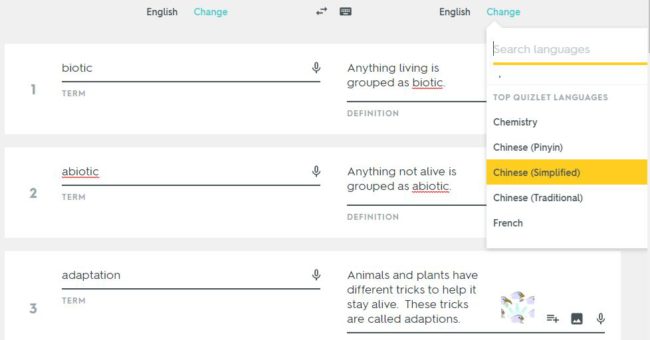
Interacting with Vocabulary Words
Quizlet offers a variety of ways to interact with the vocabulary words.
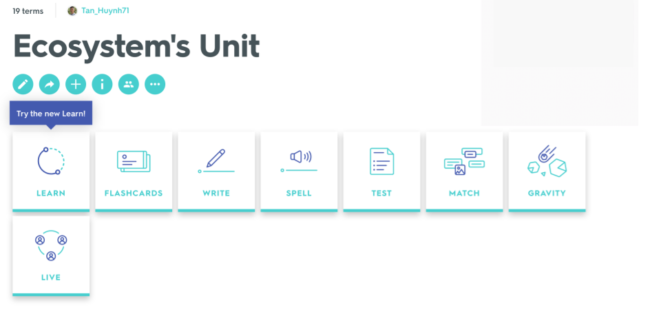
Flashcards
This function presents the vocabulary word with an image and hides the definition. Students have to remember the definition. They click to turn the flashcard back to reveal the definition.
Learn
In this function, students are given the vocabulary word and the image. They have to write the definition word-for-word to be correct. Because of the rigid nature of this function, I discourage students from using it. This function is more like a spelling test than a memorization tool.
Spell
The Spell function says the word for the student. It presents an image and offers the definition but omits the target word. Students are to type what they hear. This function is slightly better than the Learn function because it only requires students to remember the spelling of the target word – not how to spell each word in the definition.
Test
Students are given an image and the definition. They then need to write the target word. After a few of these questions, students are given multiple-choice questions. They’re given the definition, an image, and several target words. They have to pick the correct answer.
Match
In this function, students have to match the definitions with the terms. Students are timed, and they like to compete with themselves to see if they can reduce their speed. Each definition has a faded image that helps remind students of the vocabulary words.
Gravity
This is a game where students are given a term, and the term is represented by an asteroid. Students have to correctly type the definition of a term before the asteroid hits the planet. Just like the Learn and Spell function, this is basically a spelling test. Students become easily frustrated because they do have the right definitions, but the spelling mistakes cause them to lose points.
Live
Live is a paid function of Quizlet where the teacher leads a class activity using Quizlet. The teacher poses a question related to the vocabulary words, and students answer on their mobile devices or a laptop. Then students’ responses are presented in a graph.
Takeaways
Because vocabulary is key to success in content classes, we have to provide ways for ELs to interact with vocabulary words. Meaningful interactions lead to learning.
Though the best way to internalize vocabulary in content classes is to use them in authentic learning experiences (conducting a lab, building a prototype, creating a skit), the second-best approach allows students multiple ways to connect the term with its definition. Quizlet provides various ways for ELs to learn vocabulary words. It doesn’t replace vocabulary instruction; it simply augments it.
If you’re interesting enhancing learning for ELs by integrating technology, please consider reading ELL Frontiers: Using Technology to Enhance Instruction for English Learners by Heather Parris, Lisa M. Estrada, and Andrea Honigsfeld. By purchasing the book, you also support this blog.
August, D., Carlo, M., Dressler, C., & Snow, C. (2005). The critical role of vocabulary development for English language learners. Learning Disabilities Research & Practice, 20(1), 50-57.
Beck, I. L., McKeown, M. G., & Kucan, L. (2002). Bringing words to life: Robust vocabulary instruction. New York: Guilford.
Carlo, M. S., August, D., McLaughlin, B., Snow, C., Dressler, C., Lippman, D. Lively, T. J. & White, C. E. (2008). Closing the gap: Addressing the vocabulary needs of English language learners in bilingual and mainstream classrooms. Journal of Education, 189(1/2), 57-76.
Chung, S. F. (2012, September). Research-Based Vocabulary Instruction for English Language Learners. The Reading Matrix, 12(2), 105-120. Retrieved from http://www.readingmatrix.com/articles/september_2012/chung.pdf

